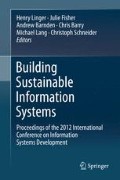Abstract
Enterprise Modeling (EM) captures and represents organizational knowledge in models that cover different views of the enterprise. The models can be leveraged in the development of information systems. Investigating how to use them as input to model-driven development (MDD) is an open challenge. This paper explores how a holistic EM approach, represented by a unifying meta-model, can benefit from integrating with Communication Analysis, a communication-oriented business process modeling and requirements engineering method. As a first step towards an integrated EM-enabled MDD approach, the unifying meta-model and Communication Analysis meta-model are aligned. A set of guidelines for transforming models conforming to the unifying meta-model to Communication Analysis models are formulated. The approach is illustrated using a lab demo.
Research is partially supported by the Spanish Ministry of Science and Innovation project PROS-Req (TIN2010-19130-C02-02), the Generalitat Valenciana project ORCA (PROMETEO/2009/015), and the Santiago Grisolía grant (GRISOLIA/2011/005) and cofinanced by ERDF structural funds and Jubileumsdonationen K & A Wallenbergs Stiftelse.
Access this chapter
Tax calculation will be finalised at checkout
Purchases are for personal use only
Notes
- 1.
The current CA meta-model does not support communicative event refinement; this guideline is included for future extensibility.
References
Bubenko JA Jr, Persson A, Stirna J (2001) D3: user guide of the knowledge management approach using enterprise knowledge patterns. Royal Institute of Technology (KTH) and Stockholm University, Stockholm, Sweden
Selic B (2003) The pragmatics of model-driven development. IEEE Soft 20:19–25
Object Management Group (OMG) Unified Modeling Language. http://www.uml.org/
Object Management Group (OMG) Model Driven Architecture. http://www.omg.org/mda/
Pastor O, Molina JC (2007) Model-driven architecture in practice: a software production environment based on conceptual modeling. Springer-Verlag, Berlin
España S, González A, Pastor O (2009) Communication analysis: a requirements engineering method for information systems. In: CAiSE 2009, LNCS 5565, 2009. Springer Berlin/Heidelberg, pp 530–545
Zikra I, Stirna J, Zdravkovic J (2011) Analyzing the integration between requirements and models in model driven development. In: EMMSAD 2011, LNBIP 81, 2011. Springer Berlin Heidelberg, pp. 342–356
Zikra I, Stirna J, Zdravkovic J (2011) Bringing enterprise modeling closer to model-driven development. In: PoEM 2011, LNBIP 92, 2011. Springer, pp 268–282
España S (2011) Methodological integration of communication analysis into a model-driven software development framework, PhD Thesis, Departamento de Sistemas Informáticos y Computación (DSIC), Universitat Politècnica de València, Spain, 2011
González A, España S, Ruiz M, Pastor O (2011) Systematic derivation of class diagrams from communication-oriented business process models. In: BPMDS 2011, LNBIP 81. Springer Berlin Heidelberg, pp 246–260
España S, González A, Pastor O, Ruiz M (2011) Integration of communication analysis and the OO-method: manual derivation of the conceptual model. The SuperStationery Co. Lab Demo. CoRR 1101
Castro JF, Alencar FMR, Filhol GAC, Mylopoulos J (2001) Integrating organizational requirements and object oriented modeling. In: RE 2001, IEEE, pp 146–153
Santander VFA, Castro JFB (2002) Deriving use cases from organizational modeling. In: RE 2002. IEEE, pp 32–39
Yu ESK (1995) Modelling strategic relationships for process reengineering, PhD Thesis, University of Toronto, Toronto, Canada
Weigand H, Johannesson P, Andersson B, Bergholtz B, Edirisuriya A, Ilayperuma T (2007) Value object analysis and the transformation from value model to process model. Enterprise interoperability 2007, part II. Springer, London, pp 55–65
Object Management Group (OMG) Business Process Modelling Notation. http://www.bpmn.org
Gordijn J, Akkermans JM, van Vliet JC (2000) Value based requirements creation for electronic commerce applications. In: Proceedings of the 33rd Hawaii international conference on system sciences (HICSS-33). IEEE, 4–7 Jan 2000
Dardenne A, van Lamsweerde A, Fickas S (1993) Goal directed requirements acquisition. Sci Comput Program 20:3–50. North Holland
Koliadis G, Ghose A (2006) Relating business process models to goal-oriented requirements models in KAOS. In: PKAW 2006, LNAI 4303. Springer, pp 25–39
Author information
Authors and Affiliations
Corresponding author
Editor information
Editors and Affiliations
Rights and permissions
Copyright information
© 2013 Springer Science+Business Media, LLC
About this paper
Cite this paper
Zikra, I., España, S., Ruiz, M., Pastor, O., Stirna, J. (2013). Aligning Communication Analysis with the Unifying Meta-model for Enterprise Modeling. In: Linger, H., Fisher, J., Barnden, A., Barry, C., Lang, M., Schneider, C. (eds) Building Sustainable Information Systems. Springer, Boston, MA. https://doi.org/10.1007/978-1-4614-7540-8_46
Download citation
DOI: https://doi.org/10.1007/978-1-4614-7540-8_46
Published:
Publisher Name: Springer, Boston, MA
Print ISBN: 978-1-4614-7539-2
Online ISBN: 978-1-4614-7540-8
eBook Packages: Computer ScienceComputer Science (R0)

